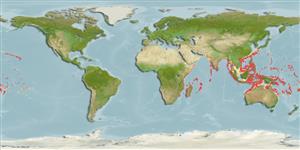Common names from other countries
>
Eupercaria/misc (Various families in series Eupercaria) >
Lutjanidae (Snappers) > Etelinae
Etymology: Pristipomoides: Greek, pristis = saw + Greek, poma, -atos = cover, operculum + Greek, oides = similar to (Ref. 45335).
More on author: Valenciennes.
Environment: milieu / climate zone / depth range / distribution range
Ecologie
marien benthopelagisch; diepte 70 - 300 m (Ref. 9821), usually 125 - 275 m (Ref. 82366). Deep-water; 35°N - 29°S, 34°E - 146°W (Ref. 55)
Indo-Pacific: East Africa to Hawaii and Tahiti, north to southern Japan, south to Australia and Lord Howe Island.
Grootte / Gewicht / Leeftijd
Maturity: Lm ? range ? - ? cm
Max length : 57.5 cm FL mannelijk / geslacht onbekend; (Ref. 107958); common length : 35.0 cm TL mannelijk / geslacht onbekend; (Ref. 30573); max. gepubliceerd gewicht: 1.8 kg (Ref. 4887)
Dorsale stekels (totaal): 10; Dorsale zachte stralen (totaal): 10-11; Anale stekels 3; Anale zachte stralen: 8. Interorbital space convex. Jaws about equal, or lower jaw slightly protruding. Bases of dorsal and anal fins without scales, their last soft rays extended into short filaments. Pectoral fins long, reaching level of anus. Scale rows on back parallel to lateral line. Overall color pink or reddish with four oblique orange or yellow bars on the sides; the dorsal and caudal fins yellow.
Adults occur over rocky bottoms (Ref. 30573) of the continental shelf and slope (Ref. 75154). They feed on fishes, shrimps, crabs, cephalopods, miscellaneous benthic invertebrates and pelagic organisms, including urochordates.
Levenscyclus en paargedrag
Maturiteit | Voortplanting | Paaien | Eieren | Fecunditeit | Larven
Allen, G.R., 1985. FAO Species Catalogue. Vol. 6. Snappers of the world. An annotated and illustrated catalogue of lutjanid species known to date. FAO Fish. Synop. 125(6):208 p. Rome: FAO. (Ref. 55)
Status op de Rode Lijst van het IUCN (Ref. 130435)
CITES (Ref. 128078)
Not Evaluated
Gevaar voor de mens
Harmless
Gebruik door de mens
Visserij: commercieel; sportvis: ja
Meer informatie
Lokale namenSynoniemenMetabolismePredatorenEcotoxicologieVoortplantingMaturiteitPaaienFecunditeitEierenOntwikkeling van de eieren
ReferentiesAquacultuurAquacultuurprofielKweeklijnenGeneticaElectrophoresesErfelijkheidZiektesVerwerkingMassaconversie
Tools
Speciale rapporten
Download XML
Internetbronnen
Estimates based on models
Preferred temperature (Ref.
115969): 12.3 - 23, mean 16.9 (based on 356 cells).
Fylogenetische diversiteitsindex (Ref.
82804): PD
50 = 0.5005 [Uniqueness, from 0.5 = low to 2.0 = high].
Bayesian length-weight: a=0.01349 (0.00781 - 0.02329), b=2.94 (2.80 - 3.08), in cm Total Length, based on LWR estimates for this species & Genus-body shape (Ref.
93245).
Trofisch niveau (Ref.
69278): 4.0 ±0.0 se; based on diet studies.
Weerstandsvermogen (Ref.
120179): Gemiddeld, minimale populatieverdubbelingstijd 1,4-4,4 jaar (K=0.23).
Fishing Vulnerability (Ref.
59153): Moderate vulnerability (42 of 100).
